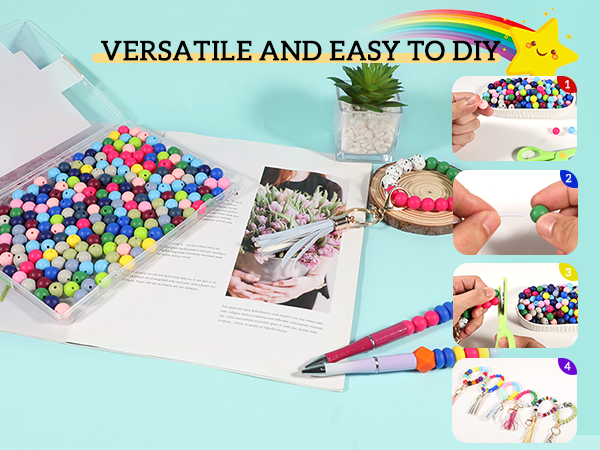Acrylic vs Silicone Beads: Key Differences for Your Project Selection
Introduction
When selecting beads for crafts, jewelry, or industrial applications, understanding the differences between acrylic and silicone beads is crucial. As a leading silicone rubber manufacturer, we often get asked about how these two materials compare. This comprehensive guide will explore their composition, properties, applications, and help you determine which type best suits your needs.
What Are Acrylic Beads?
Acrylic beads are made from polymethyl methacrylate (PMMA), a transparent thermoplastic often used as a lightweight, shatter-resistant alternative to glass. These beads are popular in craft projects and jewelry making due to their vibrant colors and glossy finish.
Key Characteristics of Acrylic Beads:
-
Lightweight and easy to work with
-
Available in a wide range of colors and finishes
-
More affordable than glass or natural stone beads
-
Less durable than silicone under stress
-
Can become brittle over time with UV exposure
What Are Silicone Beads?
Silicone beads are made from silicone rubber, a synthetic material composed of silicon, oxygen, carbon, and hydrogen. As silicone manufacturers, we produce these beads with exceptional flexibility, durability, and temperature resistance.
Key Characteristics of Silicone Beads:
-
Extremely flexible and durable
-
Heat resistant (typically -40°C to 230°C)
-
Hypoallergenic and skin-safe
-
Excellent chemical resistance
-
Available in various hardness levels (from soft to firm)
Material Composition Comparison
Acrylic Composition:
-
Derived from petroleum-based chemicals
-
Polymer chains are rigid when set
-
Contains methyl methacrylate monomers
Silicone Composition:
-
Inorganic-organic polymer with Si-O backbone
-
Contains silicon combined with oxygen, carbon, and hydrogen
-
Polymer chains remain flexible even when cured
Physical Properties Face-Off
|
Property
|
Acrylic Beads
|
Silicone Beads
|
|
Density
|
1.17-1.20 g/cm³
|
1.1-1.3 g/cm³
|
|
Hardness
|
80-90 Shore D
|
20-80 Shore A
|
|
Tensile Strength
|
50-77 MPa
|
5-12 MPa
|
|
Elongation at Break
|
2-10%
|
100-1000%
|
|
Temperature Resistance
|
-20°C to 80°C
|
-40°C to 230°C
|
Durability and Longevity
Silicone beads outperform acrylic in nearly all durability tests:
-
Impact Resistance: Silicone beads can withstand significant impact without cracking
-
UV Resistance: Silicone maintains properties longer under sunlight
-
Chemical Resistance: Silicone resists oils, acids, and solvents better
-
Flex Life: Silicone can be bent thousands of times without damage
Safety Considerations
For applications involving:
-
Children's products
-
Medical devices
-
Food contact
-
Sensitive skin
Silicone beads are the superior choice due to:
-
Non-toxic composition
-
Hypoallergenic properties
-
Lack of BPA, phthalates, or latex
-
Biocompatibility certifications available
Cost Analysis
While acrylic beads typically have a lower upfront cost, silicone beads often provide better long-term value:
-
Initial Cost: Acrylic is 30-50% cheaper than silicone
-
Replacement Cost: Silicone lasts 3-5 times longer
-
Specialty Applications: Silicone's unique properties justify the premium
Common Applications Compared
Best Uses for Acrylic Beads:
-
Decorative jewelry
-
Costume accessories
-
Light-duty craft projects
-
Temporary installations
-
Budget-conscious projects
Best Uses for Silicone Beads:
-
Medical and dental applications
-
High-temperature environments
-
Industrial vibration damping
-
Children's teething jewelry
-
Marine and outdoor applications
Customization Options
Both materials offer customization, but with different capabilities:
Acrylic Customization:
-
Precise color matching
-
High-gloss or matte finishes
-
Intricate molded shapes
-
Printed designs
Silicone Customization:
-
Variable hardness levels
-
Translucent or opaque options
-
Texture variations (smooth, grippy)
-
Medical-grade formulations
-
Conductive or resistive variants
Environmental Impact
Silicone beads are more environmentally friendly because:
-
Longer lifespan reduces waste
-
Can be recycled in specialized programs
-
Doesn't release microplastics
-
Manufacturing is less energy-intensive than acrylic
Making the Right Choice for Your Project
Consider silicone beads when you need:
-
Extreme flexibility
-
High temperature resistance
-
Long-term durability
-
Safety for sensitive applications
Choose acrylic beads when:
-
Budget is primary concern
-
Rigidity is desired
-
Project has short-term use
-
High-gloss aesthetic is preferred
Conclusion
While both acrylic and silicone beads have their place in various applications, silicone beads from reputable manufacturers like our factory offer superior performance for demanding applications. Their durability, safety profile, and temperature resistance make them ideal for industrial, medical, and high-quality craft uses.
For custom silicone bead solutions tailored to your specific requirements, contact our manufacturing experts today.





 86-592-5659128 (to8016)
86-592-5659128 (to8016) anna@xmydx.com
anna@xmydx.com sallyliao1985
sallyliao1985 xmydx02
xmydx02 +86-13606037597
+86-13606037597